The deckpad serves as both a non-slip surface to better the grip your board with your feet and a cushioning layer so you can paddle all day in comfort.
I'm a big fan of the synthetic teak decking with faux grout lines between the 'planks', it completes that classic look we're going for on our stand up paddle boards.
The self-adhesive EVA foam decks are now very common place in the boating world and can be bought inexpensively from online marine retailers. As always, try to buy the best foam deck you can afford as it will stick to the board for longer and look better.
Cutting a deck pad...
-
Tape a large roll of paper over the deck. Use the 30mm wide plywood spacer to mark the curve of the foredeck and sides onto the paper.
-
Cut out the template.
-
Place the BOTTOM of the template onto the underside of the deck pad and tape it into position, be sure to line up the faux grout lines so the centre grout line matches the centre of the deck pad template.
-
Trace the outline of the template onto the bottom of the deckpad.
-
Add radius on each corner.
-
Cut out the deckpad with very sharp scissors or a circular saw with bottom of the pad facing up. (Do a test cut first if you have to.)
-
Place the paper template on the top of the deck pad to cut out the handle hole.
- Use a hole punch to make four corner holes around the handle cutout, then join the cuts with a sharp knife.



